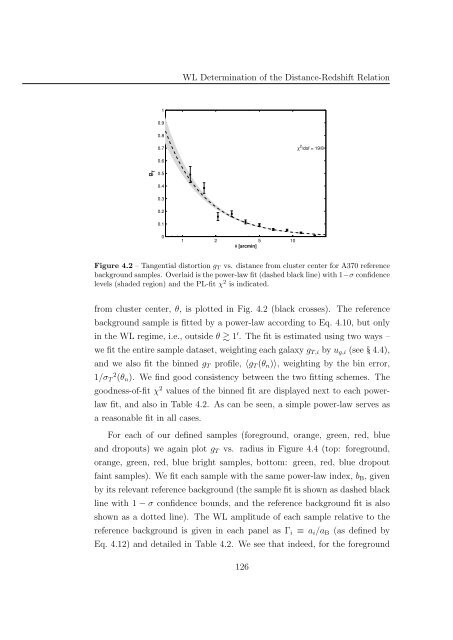Mass and Light distributions in Clusters of Galaxies - Henry A ...
Mass and Light distributions in Clusters of Galaxies - Henry A ...
Mass and Light distributions in Clusters of Galaxies - Henry A ...
You also want an ePaper? Increase the reach of your titles
YUMPU automatically turns print PDFs into web optimized ePapers that Google loves.
WL Determ<strong>in</strong>ation <strong>of</strong> the Distance-Redshift Relation<br />
1<br />
0.9<br />
0.8<br />
0.7<br />
χ 2 /d<strong>of</strong> = 19/8<br />
0.6<br />
g T<br />
0.5<br />
0.4<br />
0.3<br />
0.2<br />
0.1<br />
0<br />
1 2 5 10<br />
θ [arcm<strong>in</strong>]<br />
Figure 4.2 – Tangential distortion g T vs. distance from cluster center for A370 reference<br />
background samples. Overlaid is the power-law fit (dashed black l<strong>in</strong>e) with 1−σ confidence<br />
levels (shaded region) <strong>and</strong> the PL-fit χ 2 is <strong>in</strong>dicated.<br />
from cluster center, θ, is plotted <strong>in</strong> Fig. 4.2 (black crosses). The reference<br />
background sample is fitted by a power-law accord<strong>in</strong>g to Eq. 4.10, but only<br />
<strong>in</strong> the WL regime, i.e., outside θ 1 ′ . The fit is estimated us<strong>in</strong>g two ways –<br />
we fit the entire sample dataset, weight<strong>in</strong>g each galaxy g T,i by u g,i (see § 4.4),<br />
<strong>and</strong> we also fit the b<strong>in</strong>ned g T pr<strong>of</strong>ile, 〈g T (θ n )〉, weight<strong>in</strong>g by the b<strong>in</strong> error,<br />
1/σ 2 T (θ n ). We f<strong>in</strong>d good consistency between the two fitt<strong>in</strong>g schemes. The<br />
goodness-<strong>of</strong>-fit χ 2 values <strong>of</strong> the b<strong>in</strong>ned fit are displayed next to each powerlaw<br />
fit, <strong>and</strong> also <strong>in</strong> Table 4.2. As can be seen, a simple power-law serves as<br />
a reasonable fit <strong>in</strong> all cases.<br />
For each <strong>of</strong> our def<strong>in</strong>ed samples (foreground, orange, green, red, blue<br />
<strong>and</strong> dropouts) we aga<strong>in</strong> plot g T vs. radius <strong>in</strong> Figure 4.4 (top: foreground,<br />
orange, green, red, blue bright samples, bottom: green, red, blue dropout<br />
fa<strong>in</strong>t samples). We fit each sample with the same power-law <strong>in</strong>dex, b B , given<br />
by its relevant reference background (the sample fit is shown as dashed black<br />
l<strong>in</strong>e with 1 − σ confidence bounds, <strong>and</strong> the reference background fit is also<br />
shown as a dotted l<strong>in</strong>e). The WL amplitude <strong>of</strong> each sample relative to the<br />
reference background is given <strong>in</strong> each panel as Γ i ≡ a i /a B (as def<strong>in</strong>ed by<br />
Eq. 4.12) <strong>and</strong> detailed <strong>in</strong> Table 4.2. We see that <strong>in</strong>deed, for the foreground<br />
126
















